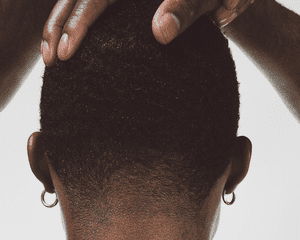
Stocksy
We know the basics of a good haircare routine: shampoo, conditioner, and the occasional hair mask. However, if you want a healthy scalp, a scalp scrub may be what your regimen is missing. After all, the scalp is the foundation of your hair health. We know what you're thinking... "great, something else to buy," but actually, DIY scalp scrubs can be just as effective as your favorite store-bought ones.
Pretty much everything you could want for an effective at-home scalp exfoliant can easily be found in your pantry or at your local grocery store. A good scrub calls for physical grains—typically sugar and salt—that work to buff away dead skin cells, flakes, and product buildup. Plus some kitchen ingredients, such as yogurt and aloe vera, double as chemical exfoliants, too.
We love DIY recipes, but we also need them to work. If we're putting in the time and effort into making an at-home concoction, we want to make sure it's going to get the job done. So, we tapped a few hair experts to share everything they know about scalp scrubs and how to make them at home for the best results.
Meet the Expert
- Robin Emtage is a Los Angeles-based hairstylist and founder of Silktáge.
- Michelle Cleveland is a hairstylist and owner of the New Jersey-based salon, Hair Addicts Salon & Extension Bar.
- Cheryl Bergamy is a celebrity hairstylist and founder of the haircare line, Contents Haircare.
- Mark Debolt is the co-founder of the Mark Ryan Salon in New York City.
What Are At-Home Scalp Scrubs?
Just as the name suggests, these DIY scalp treatments are physical scrubs that are made out of ingredients you already have at home. (Think: salt, avocado, honey, sugar, etc.) They work to buff away product build-up, excess oil, and nourish the scalp.
Why Are At-Home Scalp Scrubs So Popular?
It’s no secret that scalp treatments have been around for a while—especially as an add-on service at the salon. But recently, brands have done a great job of making and selling scrubs to already loyal consumers, and they're also relatively easy to make on your own (more on that below).
“We have come to view the treatment of our scalp equally as important as the skin on your face,” explains Mark Debolt, the co-founder of Mark Ryan Salon. “I believe this also reflects the huge success in the skincare category in recent years. Many scalp scrubs contain ingredients from the skincare world (i.e. salicylic acid or AHAs) that are able to rapidly break down and dissolve dead skin cells or product buildup. In a word borrowed from skincare: exfoliate, exfoliate, exfoliate.”
“For many years hairdressers have taught their clients to shampoo less, pointing to hair powders and dry shampoos to reduce the amount of thermal damage we put upon our hair,” explains Debolt. “Shampooing less often means more build-up on the scalp, which can interfere with the best of hair growth.”
What Are the Benefits of an At-Home Scalp Scrub?
The benefit of using a scalp scrub is to provide a deeper cleansing for the scalp by removing sweat, product build-up, dandruff, and any other residue that can stay on your scalp that may prevent hair growth.
There are a few signs to know when you should start using a scrub. Hairstylist Robin Emtage says to look for two things: whether or not your hair products aren't working as effectively as before, and if you're experiencing dandruff or a flaky scalp. If this sounds like something you're experiencing, she says a scalp scrub can help provide the necessary exfoliation to remove the dead skin cells and promote a healthier scalp.
What Are the Potential Side Effects of an At-Home Scalp Scrub?
The biggest risk associated with at-home scalp scrubs is irritation. "Overusing a scalp scrub or using one with harsh ingredients can lead to scalp irritation and dryness," explains Emtage. "It's essential to choose a gentle scrub and be mindful of the pressure applied during scrubbing."
Other than that, another side effect includes potential allergic reactions, but if you already use what's in your kitchen you likely won't run into any problems. To avoid any risks, you can always apply a patch test to see how your skin reacts.
How to Use an At-Home Scalp Scrub
Traditionally, scalp scrubs should be used right before shampooing. "This allows the scrub to effectively remove any buildup or impurities from your scalp, preparing it for the cleansing effects of the shampoo," says Emtage. "This can lead to a more thorough and effective cleaning process for your hair." Once you've used your favorite DIY scalp scrub, follow up with your regular shampoo and conditioner.
On the flip side, Scalp scrubs aren't for everyone. “I would say that they are beneficial to anyone who has product buildup or an excessively oily scalp,” shares hairstylist Michelle Cleveland. “If you already have a fairly healthy scalp and you [use] too strong of a scrub, you can actually create a problem where one didn't exist.”
Byrdie Tip
Oily hair should opt for a clarifying shampoo twice per month, whereas dry/textured hair should opt for once per month.
Can All Hair Types Use At-Home Scalp Scrubs?
Unfortunately, according to hairstylist Cheryl Bergamy, most scalp scrubs do contain sodium (salt) as a base ingredient, which doesn't serve every hair type well. “This is usually designed to remove any build-up and oils from the scalp, which can be a problem for the 4C ladies,” she explains. “[But] that does not mean 4C ladies are exempt from using one—textured hair types just need ingredients that are more gentle and moisture based that will add softness to the hair.”
Her advice: “Look for a scalp scrub that contains less salt and is more sugar-based. Although salt will pull out impurities, sugar provides moisture that will help to soften the scalp,” she explains.
Debolt is also a fan of adding a mask post-treatment. “Because these products can be drying, it is important to moisturize the hair afterward,” he explains. “Follow with a moisturizing hair mask to nourish the mid-lengths and ends of hair."
According to Cleveland, though, your hair type shouldn't play the only role in choosing a scalp scrub. “The condition of your scalp should be the most important evaluation when choosing the type of scrub,” she explains. “You can still use a scrub if you have a sensitive scalp; however, you would just need to choose more natural and milder ingredients. Typically, a pre-made one has more chances of containing unknown or unfamiliar ingredients or perfumes [that could further irritate your scalp].”
What’s the Difference Between a Clarifying Shampoo and an At-Home Scalp Scrub?
Scalp scrubs and clarifying shampoos fall into two different categories. Scalp scrubs physically exfoliate your scalp and promote a healthy base, whereas clarifying shampoos offer a deep clean of the hair.
Debolt explains that, essentially, scalp scrubs are a more intense version of a clarifying shampoo. “The greatest difference is that scalp scrubs are designed with ingredients from the skincare world and will specifically increase scalp health,” he explains.“Clarifying shampoos will achieve some of the same results but are more of an overall high detergent cleanser.”
Scalp scrubs are great for scalp stimulation, but be sure not to overuse them as this will make the scalp sore and tender. “Neither product should be used daily," says Bergamy. "It’s like going to a spa to get a facial. I suggest these products no more than twice a week. For those with a more sensitive scalp, aim to use a hair scrub once a month,” she adds.
How to Make an At-Home Scalp Scrub
1. Coconut Oil and Honey Scrub
Ingredients:
- 1/4 cup of coconut oil [Note: Swap in sweet almond or jojoba oil for finer hair textures]
- 3/4 cup sugar
- 5-6 drops of peppermint oil
- 1 tablespoon apple cider vinegar [Note: If you have dandruff, seborrheic dermatitis, psoriasis, use apple cider vinegar with caution as it can cause an itchy scalp due to its acidic properties.]
- 1 tablespoon Manuka honey
Sugar acts as a natural exfolian in this DIY recipe. Then, add an essential oil, like peppermint, as it's a natural inflammatory and is calming to the scalp. Next, ACV helps to maintain the pH balance of the skin thanks to antiseptic and antibacterial properties. Finally, adding soothing Manuka honey helps soothe the scalp while minimizing dandruff, eczema, and psoriasis.
2. Avocado and Himalayan Sea Salt Scrub
Ingredients:
- 1 tablespoon Himalayan or sea salt
- 1 teaspoon raw sugar for exfoliator
- 1 tablespoon avocado oil for moisture
- 1 teaspoon coconut oil for moisture
Overall, with DIY masks, the molecules of raw ingredients are so large that they often don't penetrate the hair strands to offer maximum benefits. But, when making a DIY mask, look for exfoliating and nourishing ingredients that you see in your favorite hair masks. A little bit goes a long way, so start with the above and add as you go along.
3. Avocado and Tea Tree Brown Sugar Scrub
Ingredients:
- 1/2 teaspoon brown sugar
- 1 teaspoon avocado oil
- 2 drops of tea tree oil
“For textured hair, if your scalp scrub is rough on the scalp or hair, you can mix a hair oil to it,” explains Bergamy. She notes to skip out on tea tree oil if your current shampoo already includes it.
4. Yogurt and Aloe Vera Scalp Scrub
Ingredients:
- 1 teaspoon coconut oil
- 4 teaspoons plain yogurt
- 1 teaspoon aloe vera
This DIY scalp treatment is especially helpful for those with sensitive scalps as the lactic acid in the yogurt and the natural salicylic acid in the aloe vera will work together to chemically buff away dead skin cells without being abrasive. Plus, the coconut oil helps soothe and nourish dry and/or irritated scalps.
Final Thoughts
Most scalps can benefit from the occasional at-home scrub, it's just about targeting their specific needs. In the same way that we all have varying skin types, our scalps may require something that differs from another person's needs. So, do some research to learn what treatments will work best for your scalp condition and goals.


